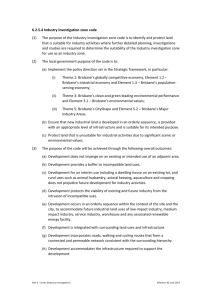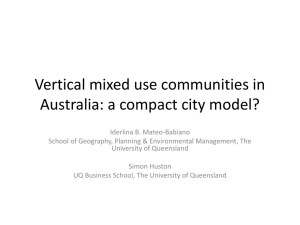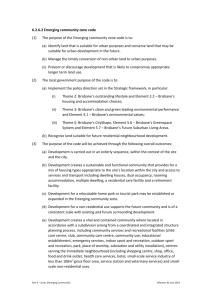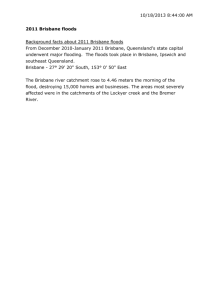File
advertisement
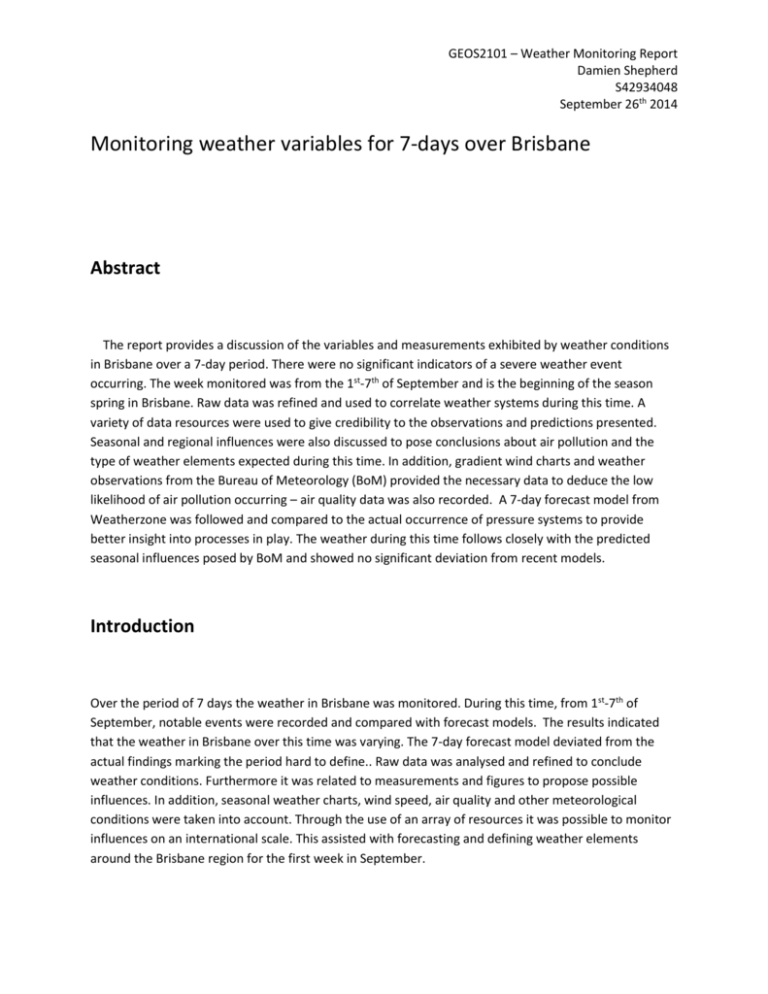
GEOS2101 – Weather Monitoring Report Damien Shepherd S42934048 September 26th 2014 Monitoring weather variables for 7-days over Brisbane Abstract The report provides a discussion of the variables and measurements exhibited by weather conditions in Brisbane over a 7-day period. There were no significant indicators of a severe weather event occurring. The week monitored was from the 1st-7th of September and is the beginning of the season spring in Brisbane. Raw data was refined and used to correlate weather systems during this time. A variety of data resources were used to give credibility to the observations and predictions presented. Seasonal and regional influences were also discussed to pose conclusions about air pollution and the type of weather elements expected during this time. In addition, gradient wind charts and weather observations from the Bureau of Meteorology (BoM) provided the necessary data to deduce the low likelihood of air pollution occurring – air quality data was also recorded. A 7-day forecast model from Weatherzone was followed and compared to the actual occurrence of pressure systems to provide better insight into processes in play. The weather during this time follows closely with the predicted seasonal influences posed by BoM and showed no significant deviation from recent models. Introduction Over the period of 7 days the weather in Brisbane was monitored. During this time, from 1st-7th of September, notable events were recorded and compared with forecast models. The results indicated that the weather in Brisbane over this time was varying. The 7-day forecast model deviated from the actual findings marking the period hard to define.. Raw data was analysed and refined to conclude weather conditions. Furthermore it was related to measurements and figures to propose possible influences. In addition, seasonal weather charts, wind speed, air quality and other meteorological conditions were taken into account. Through the use of an array of resources it was possible to monitor influences on an international scale. This assisted with forecasting and defining weather elements around the Brisbane region for the first week in September. GEOS2101 – Weather Monitoring Report Damien Shepherd S42934048 September 26th 2014 Regional and Seasonal Analysis Brisbane is situated at the base of the North-Eastern margin of Queensland, Australia. The tropical Pacific Ocean lies to the East with fringes of hinterland to the West which are back-dropped by thousands of kilometers of arid dessert. The city sits approximately 2664 kilometers south of the equator line with the Tropic of Capricorn lying 536 kilometers North near Yeppoon (Google Earth, 2014). Water pertains to parts of the Northern Murray – Darling Basin (Appendix A). The basin’s storage sits at nearly a third capacity (BoM, August 2014) compared to 51% last year. Either significant rainfall could be alleged or seasonal influences predict the changes seen. Air quality and visibility changes could also be exhibited if wind speed/direction were to intercept dry dust particles in the outer edges of the basin. The seasonal climate of Southeast Queensland during September exhibits a time of changing weather processes. The beginning of spring marks the atmospheric transition from a dry winter with stable conditions to a wet summer with unstable conditions. El Niño climate effects are also expected during this period. The El Niño is related to increasing Sea Surface Temperatures (SST) in the Pacific and other parts of the equator line. In Australia, this relates to below average rainfalls expected during SeptemberNovember (Appendix B). The Bureau of Meteorology’s ENSO tracker shows a 50% chance of it occurring in 2014 (BoM, 2014). This could be indicative of a late event occurring in rest of the El Niño 2014-2015 cycle (approx. April-March). The aim of the experiment was to conduct a thorough observation of the variables indicative of atmospheric conditions. An interpretation of the weather processes was made on a regional scale surrounding Brisbane. Variables focused on in this report include wind speed/direction, pressure, air quality and wave height. Brisbane sits around 46 kilometers West (Google Earth, 2014) of the Pacific coast. Therefore the wave heights could be indicative of surface winds present in the surrounding areas in addition to pressure charts. Other variables were considered and used to juxtapose statistics. GEOS2101 – Weather Monitoring Report Damien Shepherd S42934048 September 26th 2014 Method Each day during the week of September the 1st-7th data and figures were recorded and observed. The observation routine for each day was as follows – between the times 0600-1100 Eastern Standard Time (EST): Weather observations, wind speeds/directions, pressures, humidity data were drawn from online sources. Some sources provided spreadsheet-formatted data and others required manual tabulation of data variables. Prognosis and Synoptic data and figures were observed and recorded where necessary. Hourly Air quality data (for 0800-0900EST) from the Department of Environment and Heritage Protection’s (EHP) online source was recorded for Brisbane CBD. Further analysis of the data for South Brisbane provided better oversight of processes occurring locally. Raw data had to be managed to refine the specified regions. Spreadsheets were used to refine and store relative parts of the raw data so it could be plotted and graphed. Median Sea-Level Pressure (MSLP) charts were observed and documented via a variety of online sources. Regions included Australia, Antartica and Pacific Ocean - Southern Hemisphere. Similar patterns were noted where necessary. Average pressure was also recorded and tabled into a spreadsheet for plotting and graphing. Cloud coverage was observed and recorded using the University of Queensland’s Weather Station online source. Soundings for Brisbane Airport were observed and downloaded where appropriate. Wave heights for the Pacific were observed and downloaded using Swellnet’s Wave Activity Monitoring System (WAMS). GEOS2101 – Weather Monitoring Report Damien Shepherd S42934048 September 26th 2014 Results Meteorological Observations 1st of September: A high pressure system 1018hpa remains proximal to Brisbane city producing north-westerly winds at a speed of 4kilometers an hour (kms/h). Data was recorded at 0900EST. Progressive movement of high pressure system to the east as the afternoon ends. No precipitation of significant air pollution values. (BoM, 2014). 2nd of September: The high pressure system has now dissipated with a low pressure system 1003hpa moving up the coastline. There is a high pressure system 1028hpa over South Australia that could be influencing the movement of the low northward. A cold-front can be seen but may not impact Brisbane. A northnorthwesterly wind direction with a speed of 4km’s was recorded. Wave heights in the Pacific around Brisbane remained between 0.5-1.0ft with a possible increase towards the afternoon (Swellnet, 2014). No precipitation of significant air pollution values. (BoM, 2014). A 7-day synoptic forecast chart was recorded and was observed to depict the current conditions accurately. The charts only depict predictions for 2200EST each day. (Weatherzone, 2014). 3rd of September: The cold front appeared to have passed through Brisbane. The low pressure (1000hpa) now moves easterly towards New Zealand along with corresponding cold front that progresses ahead on the northern limb. The 1028hpa, high pressure system over South Australia remains persistent with only a slight movement to the south. A wind direction from the west and speed of 15km’s could mark the postcold front processes occurring along with a now-closer low pressure system. No precipitation of significant air pollution values. (BoM, 2014). 4th of September: MSLP charts shows the low pressure system in the east has moved south around midway between New Zealand and Australia. A new low pressure can be seen to be developing over Alice Springs, Northern Territory. The 1011hpa system has a developing cold front that could progress east but likely to stream cold air along longitudes. Wind is a south-westerly with a speed of 6 kilometers indicative of the low pressure system’s growing distance. No precipitation of significant air pollution values. (BoM, 2014). Significant wave increases from 3.0-3.5ft as opposed to 0.5-1.0ft on the 2nd of September attributed to GEOS2101 – Weather Monitoring Report Damien Shepherd S42934048 September 26th 2014 wind directions propagated from the low pressure system. (Swellnet, 2014). Some differences can be seen between the 7-day forecast charts observed on the 2nd of the September. The high pressure system over South Australia has been indicated to move north-east towards Brisbane by this time. (Figure 1). Being a model for 2200EST it could be presenting delayed effects when monitoring data at the set timeframe of 0600-0900EST. The actual MSLP chart is provided for comparative analysis (Figure 2). Frequent comparison over the next few days was needed to check validity of synoptic models posed by Weatherzone. A new high pressure may form on the east coast near Brisbane due to the low pressure activity in the pacific and southern Australia. The sounding for Brisbane Airport was recorded and observed. Air parcels rising from 900hpa are plotted closely with the Theoretical Air Parcel Plot (TAPP). (Figure 3). Therefore stable conditions are expected with no negative CAP (stable region of the atmosphere) values present. Figure 1: Weatherzone's 7-day synoptic chart for Thursday 4th of September at 2200EST. Forecast model obtained on the 2nd of September 2014.(Weatherzone, 2014). Figure 2: Bureau of Metereology's MSLP chart for Australian region on the 4th of September at 1600EST. (BoM, 2014). GEOS2101 – Weather Monitoring Report Damien Shepherd S42934048 September 26th 2014 Figure 3: Sounding diagram provided by Brisbane Storm Chaser’s online archive of the Bureau of Metereology’s daily data. The region highlighted orange shows no negative CAP values and the correlation of temperature with the TAPP between 1000-800hpa. (The Brisbane Storm Chaser, 2014). 5th of September: The wind has remained the same direction and speed with no proximal pressure systems. Most of the low pressure systems in South Australia have dissipated leaving colds streams of air. A prominent high pressure system at around 1027hpa is seen over Tasmania. The low in the pacific has moved over the northern cape of New Zealand. The weatherzone chart depicts a low pressure inland over New South Wales at 2200EST. This pressure system has not formed at 1600EST and the low pressure over New Zealand hasn’t progressed easterly as far. (Figure 4 and Figure 5). Differences could be attributed to the time delay. Figure 4: Weatherzone 7-day synoptic chart from the 2nd of September. Shows a possible difference in forecast models and occurrence. However time differences (6hours) need to be taken into account. GEOS2101 – Weather Monitoring Report Damien Shepherd S42934048 September 26th 2014 Figure 5: Bureau of Metereology MSLP analysis chart for the 5th of September at 1600EST. Presents significant differences in the later forecast model devised on the 2nd of September by Weatherzone. (BoM, 2014). 6th of September: A later model (2200EST) of the previous day’s MSLP chart was downloaded for comparison with the previous Weatherzone chart (Figure 4 and Figure 6). No high or low pressure systems can be seen where Figure 4 depicts them to be. The absence could be attributed to a miscalculation in the intensity of pressure systems. The high (1029hpa) depicted over Tasmania remains consistent with a slight difference in the distance the low pressure (999hpa) over New Zealand has moved. At 0900EST, the wind direction had changed slightly to a westerly-southwesterly and a slight speed increase of 3km/h (now 9km/h) was measured. The high pressure (1030hpa) over Tasmania has moved northeast. The MSLP charts for the 6th of September at 1600EST show that a high now exists over the south island of New Zealand with a pressure of 1016hpa. The low over the northern cape of New Zealand has progressed east making room for the high over Victoria/New South Wales. A significant low, 1013hpa, has formed inland over Mt Isa in Queensland (Figure 6). No precipitation of significant air pollution values. (BoM, 2014). GEOS2101 – Weather Monitoring Report Damien Shepherd S42934048 September 26th 2014 Figure 6: MSLP analysis chart for previous day (5th of September) at 2200EST. Mt Isa has been marked the colour red for reference. (BoM, 2014). 7th of September: The MSLP chart for Australian region was observed and analysed for 1600EST. The low pressure, 1013hpa, over Mt Isa has developed a cold stream component and begun to move slightly east. The high pressure (1031hpa) over Victoria/New South Wales has moved out to the Pacific as predicted in the previous log. The wind has changed as of 0900EST from a westerly-southwesterly to a south-easterly and the speed has upped another 2kms/h to 11kms/h. Appendix C was consulted and observed to conclude isolation of events occurring around Antarctica. No significant concentrations of air pollution were observed nor precipitation values present. (BoM, 2014). Summary of Statistics The data provided in the tables in Appendix were calculated using the original dataset from BoM. It can be seen that the mean MSLP over the 7-days was 1016.764 (including 0900EST and 1500EST measurements) in Brisbane. The average temperature was 24.53 degrees Celsius and average wind speed at 0900EST was 7.89km/h. 0mm of precipitation was seen over the 7-day period. Appendix E shows the visibility values trend downwards in value but no correlation can be made to Appendix D’s air concentration data. The forecast model from Weatherzone provided some insight into differing weather patterns and outcomes if pressure systems were absent/present. GEOS2101 – Weather Monitoring Report Damien Shepherd S42934048 September 26th 2014 Air Quality The recorded dataset included hourly Air Quality measurements for each day at 0800-0900EST. The regions recorded were ‘South Brisbane’ and ‘Brisbane CBD’. ‘Visibility’ or Nephelometer readings were also taken into consideration with respect to 20km visibility (proposed under EHP’s Air EPP Objectives). The EHP’s data source also outlines that each indexed value is sampled at different rates. These were adhered to, to avoid any duplication. Carbon monoxide was sampled every 8hours, Nitrogen dioxide ever hour and Particle PM10 every 24hours. (EHP, 2014). The results recorded for each were summarized into the table and figures below. Particle PM10 and Visibility units were transposed to another dataset to include wind speed and direction at 0900EST. Some of the above figures were used to depict wind variables experienced in Brisbane and gradient wind charts were observed (ie Figure 7) to pose possible pathways from which particles originate. This was collaborated with the use of Gradient Wind Analysis charts. Air pollution and precipitation were also taken note of as they directly affect the values seen above. (BoM, 2014). Figure 7: Gradient wind analysis for the north Pacific region. Chart is for the 7th of September at 1600EST. Direction of winds at the surface is indicated by arrows provided. (BoM, 2014). GEOS2101 – Weather Monitoring Report Damien Shepherd S42934048 September 26th 2014 Discussion The forecast model posed by Weatherzone did provide some accuracy in first few days of observation. A definitive change in what was occurring and what was predicted was seen after the 4th and 5th of September. This change shows the varying depiction of events that may have occurred in the atmosphere between those times. Some pressure systems may have never came to existence and others could have dissipated as per the 7-day forecast suggested. The basin’s capacity could be indicative of dry and exposed systems lying to the south-west of Brisbane. It could be noted that winds coming from these directions could pose a possible weather event or even create fluctuations in the indexed values monitored by EHP – especially with respect to the ‘visibility’ variable. For dust to be considered a candidate for plausible air pollution significant low-level wind speeds need to be exhibited. Judging from wind bards on the sounding taken on the 5th of September (Figure 3) it can be seen that speed increases are only seen in the upper most atmosphere. The days (1st, 4th, 5th and 6th of September) that exhibit these winds have fairly low wind speeds from 4km/h to 9km/h ruling out the likelihood of dust pollution from the South West. In addition, gradient wind charts were monitored for directional analysis of winds. The sounding also revealed details about the trapping capabilities of the lower atmosphere. As a close correlation between the temperature and the TAPP are clear signs of a stable atmosphere. Precipitation remained null characteristic of the climatic influences occurring during the beginning of September/Spring. Appendix D shows the concentrations of nitrogen dioxide and carbon monoxide in the air around Brisbane remained low with no prominent increases seen. (EHP, 2014). Conclusion During the period from the 1st-7th of September the weather in Brisbane was monitored. As discussed, the report uses raw data and figures to draw concepts that define weather conditions. In some cases, data had to be refined and correlated as per the context of the report. No significant results indicated the likelihood of air pollution occurring. By comparing conditions met and predicted forecast models, possible discrepancies were deduced. The climate and atmosphere remained stable following true to the seasonal prediction outlined by BoM. Being the start of spring, September usually marks the transition from dry to wetter climates so it can be varying due to its dependence on other climatic influences like the El Niño. Regional and international analysis of seasonal weather charts, wind speed, air quality and other meteorological conditions made it possible to impose the conclusions proposed. GEOS2101 – Weather Monitoring Report Damien Shepherd S42934048 September 26th 2014 References Bureau of Meteorology. 2014. Daily Maximum Temperature. Bureau of Meteorology, [accessed 05/09/2014]<http://www.bom.gov.au/jsp/ncc/cdio/weatherData/av?p_nccObsCode=122&p_display_ty pe=dailyDataFile&p_startYear=2014&p_c=-334897395&p_stn_num=040913/> Bureau of Meteorology. 2014. Murray Darling Basin. Bureau of Meteorology, [accessed 04/09/2014]<http://www.bom.gov.au/water/nwa/2012/mdb/contextual/physicalinformation.shtml/> Bureau of Meteorology. 2014. Weather Observations for September. Bureau of Meteorology, [accessed 04/09/2014]< http://www.bom.gov.au/climate/dwo/IDCJDW4019.latest.shtml Bureau of Meteorology. 2014. September-November Outlook – Rainfall and Temperature. Bureau of Meteorology, [accessed 04/09/2014],< http://www.bom.gov.au/climate/ahead/archive/outlooks/20140828-outlook.shtml Bureau of Meteorology. 2014. El Niño Climate Overview. Bureau of Meteorology, [accessed 04/09/2014]< http://www.bom.gov.au/climate/about/australian-climateinfluences.shtml?bookmark=elnino/> Bureau of Meteorology. 2014. September Rainfall Data. Bureau of Meteorology,[accessed 05/09/2014]<http://www.bom.gov.au/jsp/ncc/cdio/weatherData/av?p_nccObsCode=136&p_display_ty pe=dailyDataFile&p_startYear=2014&p_c=-334900284&p_stn_num=040913/> Department of Environment and Heritage Protection (EHP). 2014. Hourly Air Quality Data. Queensland Government. [accessed from 01/09/2014-07/09/2014]< http://www.ehp.qld.gov.au/air/data/search.php/> Google Earth version 7.12.2041. 2014. Brisbane City 27°28'17.96"S, 153° 1'29.62"E.<http://www.google.com/earth/index.html/> [Viewed 07/09/2014]. Swellnet. 2014. Wave Activity Monitoring System (WAMS). Online wave prediction tool. Swellnet. [accessed 02/09/2014]< http://www.swellnet.com/reports/australia/queensland/gold-coast/wams/> The Brisbane Storm Chasers. 2014. Archive for Soundings provided by the Australian Bureau of Metereology. University of Wyoming. [accessed 05/09/2014]http://soundings.bsch.au.com/index.html# Weathercharts. 2014. Metereological Charts North Atlantic and Europe Global Charts. Weathercharts.org. [accessed 07/09/2014]<http://www.weathercharts.org/indexpage2.htm> GEOS2101 – Weather Monitoring Report Damien Shepherd S42934048 September 26th 2014 Weatherzone. 2014. Synoptic 7-day forecast for Australia. Online chart. Weatherzone with data provided from Bureau of Metereology. [accessed 02/09/2014]<http://www.weatherzone.com.au/synoptic/ GEOS2101 – Weather Monitoring Report Damien Shepherd S42934048 September 26th 2014 Appendix A: (BoM, 2014) B: (BoM, 2014) GEOS2101 – Weather Monitoring Report Damien Shepherd S42934048 September 26th 2014 C: (Weathercharts, 2014) D: Air Quality data - Carbon monoxide and Nitrogen dioxide variables Date Region 1 1 2 2 3 3 4 4 5 5 6 6 7 7 Brisbane South Brisbane Brisbane South Brisbane Brisbane South Brisbane Brisbane South Brisbane Brisbane South Brisbane Brisbane South Brisbane Brisbane South Brisbane Carbon Monoxide (8hr Av) (ppm) Nitrogen Dioxide (1hr Av) (ppm) 0.2 0.032 0.2 0.029 0 0.027 0 0.033 0.1 0.031 0 0.016 0 GEOS2101 – Weather Monitoring Report Damien Shepherd S42934048 September 26th 2014 E: Air Quality Data (Particle PM10 and Visibility variables) with respect to Wind Speed. Date Region 1 Particle PM10 (24hr Av) (ug/m3) 14.4 Brisbane South Brisbane Brisbane South Brisbane Brisbane South Brisbane Brisbane South Brisbane Brisbane South Brisbane Brisbane South Brisbane Brisbane South Brisbane 1 2 2 3 3 4 4 5 5 6 6 7 7 Particle PM10 (24hr Av) (ug/m3) Visibility (1hr Av) (Mm1) 28 14.6 13.4 7.2 16.5 8.6 7.4 8.7 8.6 2.7 8.6 15.9 3.5 15.6 14 7.6 12.3 15.6 4 13.8 4.8 34 8 10 19 6 Wind Speed km/h WSW 4 WSW 5 NNW 4 NNW 4 W 15 W 15 SW 6 SW 6 SW 6 SW 6 WSW 9 WSW 9 SE 11 SE 11 F: Compiled dataset using the Bureau of Metereology’s observational data. (BoM, 2014). Temps Min Max °C Max wind gust Rain °C Dir mm Spd km/h 9:00 AM Time local Temp RH Cld °C % 8th Dir Spd MSLP km/h hPa 13.4 25.3 0 NE 24 16:42 19.8 69 1 WSW 4 1019.8 12 29.1 0 WNW 43 15:42 18.3 60 7 NNW 4 1013.6 10.9 23.1 0 W 44 12:29 16.3 37 1 W 15 1012.7 10 23.9 0 WNW 26 13:24 17.3 31 1 SW 6 1015 9.1 23.8 0 ENE 24 15:31 16.7 48 1 SW 6 1018.2 11.5 23.4 0 SE 30 16:22 17.6 56 1 WSW 9 1025.1 12.9 23.1 0 ESE 30 12:58 19.5 56 5 SE 11 1027.1 AVGMSLP 9AM 1018.786 AVGMSLP 3PM 1014.743 Mean MSLP 1016.764 AVG Temp 24.52857 AVG wind speed 7.857143


